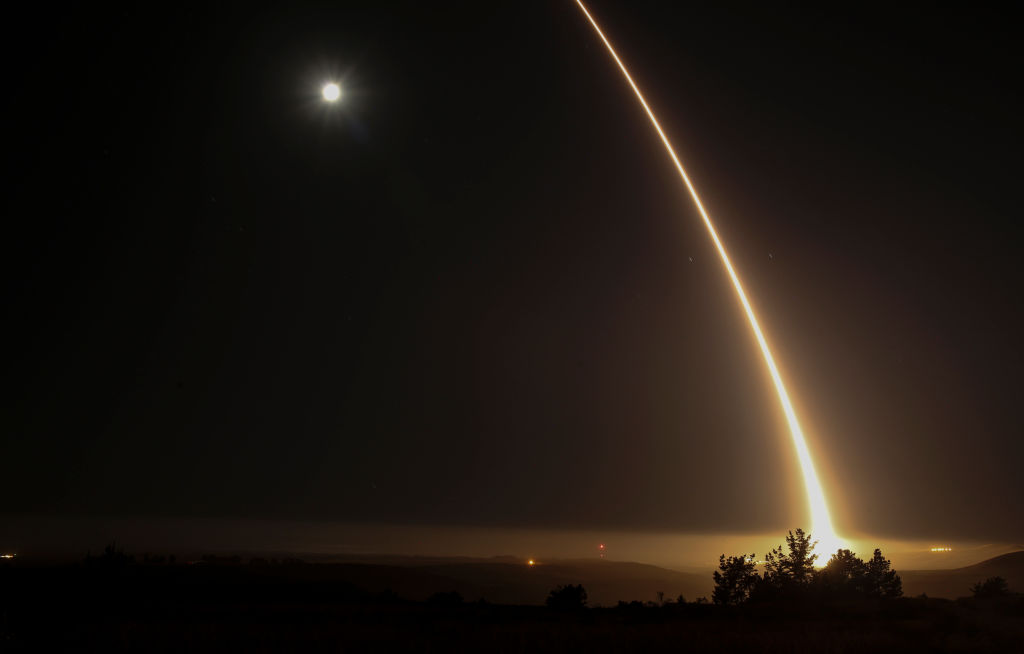
As Russia and China continue to expand their nuclear arsenals, the U.S. is unprepared for the prospect of facing two nuclear equals for the first time, a new bipartisan Congressional report warns. The report describes the growing threat from Russia and China, and calls for a dramatic overhaul of America’s nuclear arsenal and strategic posture.
"It is an existential challenge for which the United States is ill-prepared, unless its leaders make decisions now," the report says.
“It is apparent from the report that there is much more that we should be doing to ensure our military, and particularly our nuclear forces, are capable of deterring two near-peer nuclear adversaries at the same time,” Roger Wicker, a top Republican on the U.S. Senate Committee on Armed Services, said in a statement following the report's release.
The 145-page assessment, laid out in a report released on Thursday by the Congressional Commission on the Strategic Posture of the United States, was led by a group of leading bipartisan nuclear experts and is the result of a year-long effort.
More From TIME
For Republicans, the report is likely to be used as political ammunition against President Joe Biden. “The Administration's stated and preferred policies really have not measured up to the really dangerous times that we're living in,” one Republican aide tells TIME, who spoke on condition of anonymity to discuss the contents of the report prior to its release.
Read More: Inside the $100 Billion Mission to Modernize America’s Aging Nuclear Missiles
China will reach parity with the U.S. in deployed nuclear warheads by the mid-2030s if it continues expanding its nuclear arsenal at current rates, the report warns. On top of that, Russia will likely continue to be the largest nuclear force in the world. The U.S. has an estimated stockpile of 3,708 nuclear warheads, while Russia has more than 4,000, according to reports by the Federation of American Scientists, a U.S.-based think-tank. China’s estimated stockpile includes about 410 nuclear warheads, according to FAS.
While the report focuses heavily on a worst-case scenario of coordinated Russian and Chinese aggression, Ankit Panda, a nuclear expert at the Carnegie Endowment for International Peace, says that the commission has focused too singularly on this threat. This should "be better borne out by the evidence we've seen of how Moscow and Beijing cooperate in crises," he says, adding: “the other thing here is if the prescriptions are followed, the United States, I think, is very likely to find itself in a new arms race.”
The Biden Administration has sought to tamp down on fears of facing two major nuclear adversaries. “The United States does not need to increase our nuclear forces to outnumber the combined total of our competitors in order to successfully deter them,” Biden’s National Security Adviser Jake Sullivan said in June. Sullivan also said that the U.S.’s advanced non-nuclear weaponry will likely remain far more capable than its rivals'.
Some experts tell TIME that the existing initiatives to upgrade the U.S.'s nuclear arsenal—at an estimated cost of over $1 trillion over the next three decades—are already sufficient for national security purposes. “My priority would not be on going beyond the current modernization plan,” says Lynn Rusten, vice president for the Nuclear Threat Initiative think-tank's Global Nuclear Policy Program.
Rusten says her priority “would be just having a sensible deterrent, pursuing diplomacy to keep Russia under limits, have a dialogue with China to understand what they're doing, and seeing if we can stop what could become a nuclear arms race in the Asia-Pacific.”
Securing funds for the modernization program has at times been a challenge. “Now, you know, funds get authorized but they don't get appropriated,” says Rose Gottemoeller, one of the commissioners of the report and former Deputy Secretary General of NATO. “It's very important that Congress stay focused on the funding that's required.”
In addition to speeding up the modernization program, the report calls for increasing weapons production including B-21 stealth bombers and intercontinental missiles, and expanding the country’s nuclear weapons industrial base to upgrade 1940s-era Manhattan Project facilities.
“While it requires significant investment to maintain a strategic posture sufficient to prevent war with a major power, it will be far more expensive, in lives and resources, to fight such a war,” the report says.
More Must-Reads From TIME
- The 100 Most Influential People of 2024
- Coco Gauff Is Playing for Herself Now
- Scenes From Pro-Palestinian Encampments Across U.S. Universities
- 6 Compliments That Land Every Time
- If You're Dating Right Now , You're Brave: Column
- The AI That Could Heal a Divided Internet
- Fallout Is a Brilliant Model for the Future of Video Game Adaptations
- Want Weekly Recs on What to Watch, Read, and More? Sign Up for Worth Your Time
Contact us at letters@time.com